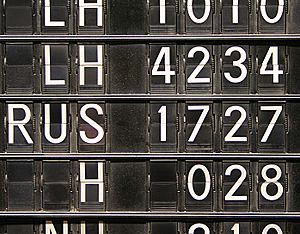Flight number facts for kids
A flight number, when combined with the name of the airline and the date, helps to identify a specific flight. Think of it like a special code for a trip! This number is a type of callsign and should not be confused with the tail number of the aircraft. The tail number is like a car's license plate, unique to that specific plane. A single aircraft might fly many different flights in one day, and different planes can be used for the same flight number on different days.
Contents
What is a Flight Number?
A flight number is a special code that an airline gives to a specific flight route and time. For example, "Flight BA249" tells you it's a British Airways flight on a particular route. These numbers help everyone, from air traffic controllers to passengers, know exactly which flight is which. They are super important for keeping track of planes and making sure everything runs smoothly.
How Flight Numbers Work
A flight number usually includes a two-letter or two-character IATA airline designator (like 'BA' for British Airways or 'AA' for American Airlines) followed by a number. The number itself often tells you something about the flight:
- Even numbers: These usually mean the flight is going north or east.
- Odd numbers: These often mean the flight is going south or west.
- Lower numbers: These might be used for more important or long-haul flights.
- Higher numbers: These could be for shorter flights or special routes.
Airlines also use flight numbers to show if a flight is a direct flight, a connecting flight, or a code-share flight (where two airlines share the same flight).
Flight Number vs. Tail Number
It's easy to mix up a flight number with a tail number, but they are very different!
- A flight number identifies a specific journey or route at a certain time. It's like the bus route number (e.g., "Bus 23 to Main Street").
- A tail number (also called an aircraft registration) is a unique code painted on the tail of an aircraft. It identifies that specific plane, just like a car's license plate. For example, an airplane might have the tail number "N123AB."
The same plane (with its unique tail number) can fly many different flight numbers in one day. Also, the same flight number (e.g., "Flight AA100") might be flown by different planes (with different tail numbers) on different days.
Why Flight Numbers Change
Sometimes, a flight number might change. This can happen for a few reasons:
- Delays or cancellations: If a flight is delayed a lot or cancelled and then rescheduled, it might get a new flight number.
- Special flights: Sometimes, extra flights are added for busy times, and these will have unique numbers.
- Operational reasons: Airlines might change numbers for internal reasons, like updating their schedules or routes.
Knowing the flight number helps everyone involved in air travel, from the pilots and air traffic controllers to the ground crew and passengers, stay organized and informed.
See also
 In Spanish: Número de vuelo para niños
In Spanish: Número de vuelo para niños


